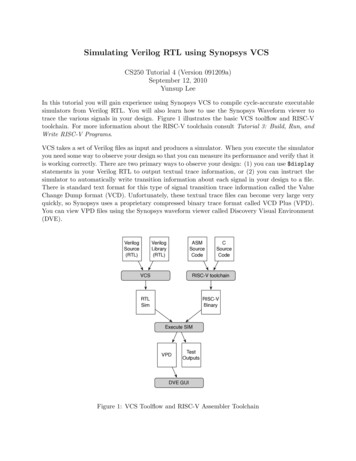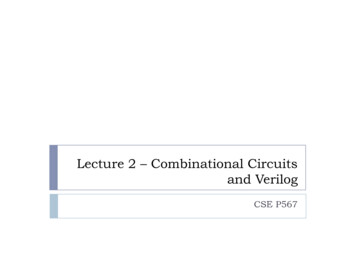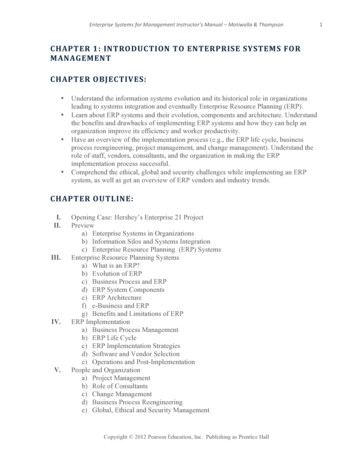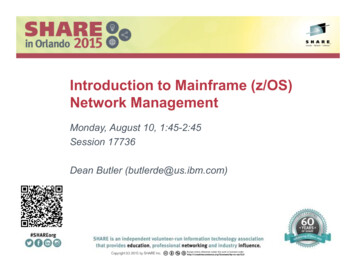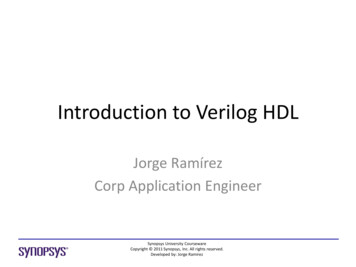
Transcription
Introduction to Verilog HDLJorge RamírezCorp Application EngineerSynopsys University CoursewareCopyright 2011 Synopsys, Inc. All rights reserved.Developed by: Jorge Ramirez
Outline HDL VerilogSynthesis Verilog tutorialSynthesis coding guidelinesVerilog - Test benchFine State MachinesReferencesSynopsys University CoursewareCopyright 2011 Synopsys, Inc. All rights reserved.Developed by: Jorge RamirezLexical elementsData type representationStructures and HierarchyOperatorsAssignmentsControl statementsTask and functionsGenerate blocks
HDL VERILOGSynopsys University CoursewareCopyright 2011 Synopsys, Inc. All rights reserved.Developed by: Jorge Ramirez
What is HDL? Hard & Difficult Language?– No, means Hardware Description Language High Level Language– To describe the circuits by syntax and sentences– As oppose to circuit described by schematics Widely used HDLs– Verilog – Similar to C– SystemVerilog – Similar to C – VHDL – Similar to PASCALSynopsys University CoursewareCopyright 2011 Synopsys, Inc. All rights reserved.Developed by: Jorge Ramirez
Verilog Verilog was developed by Gateway DesignAutomation as a proprietary language for logicsimulation in 1984. Gateway was acquired by Cadence in 1989 Verilog was made an open standard in 1990under the control of Open Verilog International. The language became an IEEE standard in 1995(IEEE STD 1364) and was updated in 2001 and2005.Synopsys University CoursewareCopyright 2011 Synopsys, Inc. All rights reserved.Developed by: Jorge Ramirez
SystemVerilog SystemVerilog is the industry's first unifiedhardware description and verification language Started with Superlog language to Accellera in2002 Verification functionality (base on OpenVeralanguage) came from Synopsys In 2005 SystemVerilog was adopted as IEEEStandard (1800-2005). The current version is1800-2009Synopsys University CoursewareCopyright 2011 Synopsys, Inc. All rights reserved.Developed by: Jorge Ramirez
IEEE-1364 / IEEE-1800Verilog 2005 (IEEE Standard1364-2005) consists of minorcorrections, spec clarifications,and a few new languagefeaturesSystemVerilog is a superset ofVerilog-2005, with many newfeatures and capabilities to aiddesign-verification and designmodelingSynopsys University CoursewareCopyright 2011 Synopsys, Inc. All rights reserved.Developed by: Jorge Ramirez
Types of modeling Behavioral– Models describe what a moduledoes.– Use of assignment statements,loops, if, else kind of statements Structural– Describes the structure of thehardware components– Interconnections of primitive gates(AND, OR, NAND, NOR, etc.) andother modulesSynopsys University CoursewareCopyright 2011 Synopsys, Inc. All rights reserved.Developed by: Jorge RamirezrstCounterclkIf (rst)cnt 0;elsecnt cnt 1;cnt [0:3]
Behavioral - StructuralBehavioralStructuralmodule cter (input rst, clock,output reg [1:0] count);always@(posedge clock)beginif (rst) count 0;elsecount count 1;endendmodulemodule cter ( rst, clock, count );output [1:0] count;input rst, clock;wireN5, n1, n4, n5, n6;FFD U0 (.D(N5), .CP(clock),.Q(count[0]), .QN(n6));FFD U1 (.D(n1), .CP(clock),.Q(count[1]), .QN(n5));MUX21 U2 (.A(N5), .B(n4),.S(n5), .Z(n1) );NR U3 (.A(n6), .B(rst), .Z(n4));NR U4 (.A(count[0]), .B(rst),.Z(N5));endmoduleSynopsys University CoursewareCopyright 2011 Synopsys, Inc. All rights reserved.Developed by: Jorge Ramirez
Simulation and Synthesis The two major purposes of HDLs are logicsimulation and synthesis– During simulation, inputs are applied to a module, andthe outputs are checked to verify that the moduleoperates correctly– During synthesis, the textual description of a moduleis transformed into logic gates Circuit descriptions in HDL resemble code in aprogramming language. But the code is intendedto represent hardwareSynopsys University CoursewareCopyright 2011 Synopsys, Inc. All rights reserved.Developed by: Jorge Ramirez
Simulation and Synthesis Not all of the Verilog commands can besynthesized into hardware Our primary interest is to build hardware, we willemphasize a synthesizable subset of the language Will divide HDL code into synthesizable modulesand a test bench (simulation).– The synthesizable modules describe the hardware.– The test bench checks whether the output results arecorrect (only for simulation and cannot besynthesized)Synopsys University CoursewareCopyright 2011 Synopsys, Inc. All rights reserved.Developed by: Jorge Ramirez
SYNTHESIS VERILOG TUTORIALSynopsys University CoursewareCopyright 2011 Synopsys, Inc. All rights reserved.Developed by: Jorge Ramirez
Outline Lexical elementsData type representationStructures and HierarchyOperatorsAssignmentsControl statementsTask and functionsGenerate blocksSynopsys University CoursewareCopyright 2011 Synopsys, Inc. All rights reserved.Developed by: Jorge Ramirez
Lexical elements Case sensitive - keywords are lower case Semicolons(;) are line terminators Comments:– One line comments start with // .– Multi-line comments start with /*and endwith*/ System tasks and functions start with a dollarsign, ex display, signedSynopsys University CoursewareCopyright 2011 Synopsys, Inc. All rights reserved.Developed by: Jorge Ramirez
Lexical elements Variable names have to start with an alphabeticcharacter or underscore ( ) followed byalphanumeric or underscore characters Escaped identifiers (\)– Permit non alphanumeric characters in Verilog name– The escaped name includes all the charactersfollowing the backslash until the first white spacecharacterwire \fo o a ; // Declare the varaible fo o a awire \fo o a ; // Assign a to wire fo oSynopsys University CoursewareCopyright 2011 Synopsys, Inc. All rights reserved.Developed by: Jorge Ramirez
Compiler directives The directives start witha grave accent ( )followed by somekeyword include “file1.v”// Used as WORD SIZE in code define WORD SIZE 32 defineText-macro substitution ifdef, ifndef, else, endifConditional compilation includeFile inclusionmodule test (); ifdef TEST// A implementation else// B implementation endifassign out WORD SIZE{1’b1};endmoduleSynopsys University CoursewareCopyright 2011 Synopsys, Inc. All rights reserved.Developed by: Jorge Ramirez
Reserved ributeendendcaseendfunction endprimitive redsmallspecifyspecparamstrong0strong1rtranif0 k0weak1whilewireworSynopsys University CoursewareCopyright 2011 Synopsys, Inc. All rights reserved.Developed by: Jorge Ramirez
Outline Lexical elementsData type representationStructures and HierarchyOperatorsAssignmentsControl statementsTask and functionsGenerate blocksSynopsys University CoursewareCopyright 2011 Synopsys, Inc. All rights reserved.Developed by: Jorge Ramirez
Logical values A bit can have any of these values– 0 representing logic low (false)– 1 representing logic high (true)– X representing either 0, 1, or Z– Z representing high impedance for tri-state(unconnected inputs are set to Z)Synopsys University CoursewareCopyright 2011 Synopsys, Inc. All rights reserved.Developed by: Jorge Ramirez
Logical values Logic with multilevel (0,1,X,Z) logic values– Nand anything with 0 is 1– Nand two get an X True tables define the how outputs arecompute&01XZ00000101XXX0XXXZ0XXX 01XZ001XXSynopsys University CoursewareCopyright 2011 Synopsys, Inc. All rights reserved.Developed by: Jorge Ramirez11111XX1XXZX1XX
Number representation size ' base format number size :– number of bits (optional) base format :– It is a single character ' followed by one of the followingcharacters b, d, o and h, which stand for binary, decimal,octal and hex, respectively. number – Contains digits which are legal for the base format – ‘ ’ underscore can be use for readabilitySynopsys University CoursewareCopyright 2011 Synopsys, Inc. All rights reserved.Developed by: Jorge Ramirez
Number representation Negative numbers are store as 2’scomplement Extended number– If MSB is 0, X or Z number is extended to fill MSBswith 0, X, Z respectively3’b01 3’b0013’bx1 3’bxx13’bz 3’bzz– If MSB is 1 number is extend to fill MSBs with 0/1,depending on the sign3’b1 3’b001-3’b1 -3’b01 3’b111Synopsys University CoursewareCopyright 2011 Synopsys, Inc. All rights reserved.Developed by: Jorge Ramirez
Number representationUnsized numbers (at least 32 bit)549// decimal number'h8F F // hex number'o765// octal numberSize numbers4'b11//3'b10x //8'hz//4'hz1//5'd3//4-bit binary number 00113-bit binary number with LSM bit unknown8-bit binary high-impedance number4’bzzz15-bit decimal numberSigned numbers-8'd6// 8-bit two's complement of 6 (-6)4'shF // 4-bit number ‘1111’ to be interpreted as// 2’s complement numberSynopsys University CoursewareCopyright 2011 Synopsys, Inc. All rights reserved.Developed by: Jorge Ramirez
Data types (reg) A reg (reg) stores its value from oneassignment to the next (model data storageelements)– Don’t confuse reg with register– Default value is X– Default range is one bit– By default are unsigned, but can be declaresigned, using keyword signedSynopsys University CoursewareCopyright 2011 Synopsys, Inc. All rights reserved.Developed by: Jorge Ramirez
Data types (Nets) Nets (wire) correspond to physical wires thatconnect instances– Nets do not store values– Have to be continuously driven– The default range is one bit– By default are unsigned The wire declaration is used most frequently,other net types are wand, wor, tri, triand,trior, etc.Synopsys University CoursewareCopyright 2011 Synopsys, Inc. All rights reserved.Developed by: Jorge Ramirez
Other data types Integer (integer)– Convenient to counting purposes– At least 32-bit wide– Useful for loop Real (real) simulation only– Can be specified in decimal and scientific notationSynopsys University CoursewareCopyright 2011 Synopsys, Inc. All rights reserved.Developed by: Jorge Ramirez
Verilog vectorsKnow as BUS in hardware Declare by a range following the type data type [left range : right range] Variable name Single element that is n-bits widereg [0:7] A, B; //Two 8-bit reg with MSB as the 0th bitwire [3:0] Data; //4-bit wide wire MSB as the 4th bit Vector part select (access)A[5]// bit # 5 of vector AData[2:0] // Three LSB of vector DataSynopsys University CoursewareCopyright 2011 Synopsys, Inc. All rights reserved.Developed by: Jorge Ramirez
Verilog arrays Array: range follows the name datatype array name [ array indices ]reg B [15:0]; // array of 16 reg elements Array of vectors data type [ vector indices ] arrayname [ array indices ]reg [15:0] C [1023:0]; // array of vectors Memory access var name [ array indices ] [ vector indices ]Synopsys University CoursewareCopyright 2011 Synopsys, Inc. All rights reserved.Developed by: Jorge Ramirez
Data storage and Verilog arraysSimple RAM Modelmodule RAM (output [7:0]input [7:0]input [3:0]input);reg [7:0] Storage[15:0];reg [7:0] ObusReg;Obus,Ibus,Adr,Clk, Readassign Obus ObusReg;always @(posedge Clk)if (Read 1’b0) Storage[Adr] Ibus;elseObusReg Storage[Adr];endmoduleSynopsys University CoursewareCopyright 2011 Synopsys, Inc. All rights reserved.Developed by: Jorge Ramirez
Data storage and Verilog arraysCountermodule cter (input rst, clock, jmp,input [7:0] jump,output reg [7:0] count);always@(posedge clock)beginif(rst) count 8’h00;else if (jmp) count jump count;elsecount count 8’h1;endendmoduleSynopsys University CoursewareCopyright 2011 Synopsys, Inc. All rights reserved.Developed by: Jorge Ramirez
Outline Lexical elementsData type representationStructures and HierarchyOperatorsAssignmentsControl statementsTask and functionsGenerate blocksSynopsys University CoursewareCopyright 2011 Synopsys, Inc. All rights reserved.Developed by: Jorge Ramirez
Structures and Hierarchy Hierarchical HDL structures are achieved bydefining modules and instantiating modulesTOPtop.vcomp.vCOMPMUXmux.vSynopsys University CoursewareCopyright 2011 Synopsys, Inc. All rights reserved.Developed by: Jorge Ramirez
Module declarationmodule module name #( param list ) ( port list ); Declarations Instantiations Data flow statements Behavioral blocks task and functions endmoduleSynopsys University CoursewareCopyright 2011 Synopsys, Inc. All rights reserved.Developed by: Jorge Ramirez
Module header Start with module keyword, contains the I/O ports Port declarations begins with output, input orinout follow by bus indices Each directions are followed by one or more I/Onames Each declaration is separated by comma (,)module ALU (output [31:0] z,input [15:0] A, B,input clock, ena);Synopsys University CoursewareCopyright 2011 Synopsys, Inc. All rights reserved.Developed by: Jorge Ramirez
Port declaration input and inout are declared as wires outputs port can be declared as reg (holds avalue) 2 flavors for port declaration:module S1 (a, b, c, d, e);input [1:0] a, b;input c;output reg [1:0] d;output e;//Verilog 1995 Styleendmodulemodule S2 (input [1:0] a, b,input c,output reg [1:0] d,output e);//ANSI C StyleendmoduleSynopsys University CoursewareCopyright 2011 Synopsys, Inc. All rights reserved.Developed by: Jorge Ramirez
Parameters Parameters are means of giving names toconstant values The values can be overridden when the designis compiled Parameters cannot be used as variables Syntax:parameter name constant expression ;Synopsys University CoursewareCopyright 2011 Synopsys, Inc. All rights reserved.Developed by: Jorge Ramirez
Parameter declaration Default value need to be set at declaration time 32 bit wide by default, but may be declared ofany widthparameter [2:0] IDLE 3’d0; 2 declaration flavors:Inside a modulemodule test (.parameter ASIZE // reg [ASIZE -1:0]wire [BSIZE-1:0]// endmoduleI/O’s .)32, BSIZE 16;Abus, Zbus;Bwire;In module headermodule test#(parameter ASIZE 32, BSIZE 16)(. I/O’s .);// reg [ASIZE -1:0] Abus, Zbus;wire [BSIZE-1:0] Bwire;// endmoduleSynopsys University CoursewareCopyright 2011 Synopsys, Inc. All rights reserved.Developed by: Jorge Ramirez
Examplemodule Adder (A, B, Cin, S,Cout, Clk);parameter N 8;input [N-1:0]A, B;input Cin;input Clk;output [N-1:0] S;output Cout;reg [N-1:0] S;reg Cout;//module internalsendmoduleANSI C styleA[N-1:0]B[N-1:0]CinAdderN-bits(8 by default)reg-ouputsS[N-1:0]CoutClkmodule Adder #(parameter N 8)(input [N-1:0]A, B,input Cin,input Clk,output reg [N-1:0] S,output reg Cout);//module internalsendmoduleSynopsys University CoursewareCopyright 2011 Synopsys, Inc. All rights reserved.Developed by: Jorge Ramirez
Structures and Hierarchy Instance of a module– Instantiation is the process of “calling” a module– Create objects from a module template module name #( param list ) instance name ( port list );Where:Module to be instantiated param list Parameters values passed to the instance instance name Identifies the instance of the module port list Port list connection module name Synopsys University CoursewareCopyright 2011 Synopsys, Inc. All rights reserved.Developed by: Jorge Ramirez
Port list connections Ports– Provide the interface by which a module cancommunicate with the environment– Port declarations (input, output, inout)reg o netnetreg o netinputoutputnetinoutnetSynopsys University CoursewareCopyright 2011 Synopsys, Inc. All rights reserved.Developed by: Jorge Ramireznet
Port connections/Parameter overwrite Named connection– Explicitly linking the 2 names for each side of theconnectionmy mod #(.W(1), .N(4)) U1 (.in1(a), .in2(b),.out(c)); Order connection– Expression shall be listed in the same order as theport declarationmy mod #(1,4) U2 (a, b, c);Synopsys University CoursewareCopyright 2011 Synopsys, Inc. All rights reserved.Developed by: Jorge Ramirez
Hierarchy exampleTOPU1ALUS1FIFOU2MEMmodule TOP ( port list );ALU U1 ( port connection );MEM U2 ( port connection );endmodulemodule ALU ( port list );FIFO S1 ( port connection );endmodulemodule FIFO ( port list );//.endmoduleSynopsys University CoursewareCopyright 2011 Synopsys, Inc. All rights reserved.Developed by: Jorge Ramirez
Outline Lexical elementsData type representationStructures and HierarchyOperatorsAssignmentsControl statementsTask and functionsGenerate blocksSynopsys University CoursewareCopyright 2011 Synopsys, Inc. All rights reserved.Developed by: Jorge Ramirez
Relational operators Mainly use in expression (e.g. if sentences) Returns a logical value (1/true 0/false) If there are any X or Z bit returns X (false on aexpression) a ba ba ba b////////isisisisaaaaless than b?greater than b?greater than or equal to bless than or equal to bSynopsys University CoursewareCopyright 2011 Synopsys, Inc. All rights reserved.Developed by: Jorge Ramirez
Arithmetic operators Binary operators– Takes 2 operators Unary operators ( /-)– Specify the sign of the operand– Negative numbers are represented as 2’scomplement*/ %c a * b ;c a / b ;sum a b ;diff a - b ;amodb a % b ;//////////multiply a with bint divide a by badd a and bsubtract b from aa mod(b)Synopsys University CoursewareCopyright 2011 Synopsys, Inc. All rights reserved.Developed by: Jorge Ramirez
Logical operators Logical operators evaluate to a 1-bit value&& !a && b ;// is a and b true? returns 1-bit true/falsea b ;// is a or b true? returns 1-bit true/falseif (!a) c b; // if a is not true assign b to c If an operant is not zero is treat as logical 1A 3; B 0;A&&B //Evaluates to 0 Equivalent to (logical-1 && logical-0)!B//Evaluates to 1 Equivalent to (!logical-0) If an operant is Z o X is treat as X (false)A 2’b0x; B 2’b10;A&&B //Evaluates to x Equivalent to (x && logical-0)Synopsys University CoursewareCopyright 2011 Synopsys, Inc. All rights reserved.Developed by: Jorge Ramirez
Equality and Identity operators c a ; /* is c equal to a returns 1-bit true/falseapplies for 1 or 0, logic equality, using X orZ operands returns always false ('hx 'h5returns 0) */! c ! a ; // is c not equal to a, returns 1-bit true a b ; // is a identical to b (includes 0, 1, x, z)/* is a not identical to b returns 1-bit! a ! b ;true/false*/Synopsys University CoursewareCopyright 2011 Synopsys, Inc. All rights reserved.Developed by: Jorge Ramirez
Bitwise and Reduction operations&b &a ; b a ; b a ; &, , c & b ; ,&, , b a ; e b a &, , e a b ;/* AND all bits of a(reduction) *//*OR all bits (reduction)*//*Exclusive or all bits ofa (reduction)*//* NAND, NOR, EX-NOR allbits together *//*bit-wise NOT, AND, OR,EX-OR*//*bit-wise NAND, NOR, EXNOR*/Synopsys University CoursewareCopyright 2011 Synopsys, Inc. All rights reserved.Developed by: Jorge Ramirez
Shift and other operator a 1 ;// shift left a by 1-bit a 1 ;// shift right a by 1 b 1 ;// arithmetic shift by 1 b 1 ;// arithmetic shift by 1?:c sel ? a : b ;{}{{}}/* if sel is true c a, else c b , ?: ternary operator *//* add a, b, ci assign theoverflow to co and the result to{co, sum} a b ci;sum: operator is calledconcatenation */b {3{a}}/* replicate a 3 times,equivalent to {a,a,a} */Synopsys University CoursewareCopyright 2011 Synopsys, Inc. All rights reserved.Developed by: Jorge Ramirez
Operators precedenceOperator precedenceUnary, Multiply, Divide,ModulusAdd, subtract, shiftRelationalEqualityReductionLogicalConditional ,-,!, *, / % , . , , , , . ! , ! &, & , , && Highest?:LowestSynopsys University CoursewareCopyright 2011 Synopsys, Inc. All rights reserved.Developed by: Jorge Ramirez
Outline Lexical elementsData type representationStructures and HierarchyOperatorsAssignmentsControl statementsTask and functionsGenerate blocksSynopsys University CoursewareCopyright 2011 Synopsys, Inc. All rights reserved.Developed by: Jorge Ramirez
Concurrent blocks Blocks of code with no well-defined orderrelative to one another– Module instance is the most important concurrentblock– Continuous assignments, and procedural blocksare concurrent within a modulemodule AND (input A, B, output C);wire w;NAND U1 (A, B, w);NAND U2 (w, w, C);endmoduleSynopsys University CoursewareCopyright 2011 Synopsys, Inc. All rights reserved.Developed by: Jorge Ramirez
Continuous assignments Continuous assignments imply that wheneverany change on the RHS of the assignmentoccurs, it is evaluated and assigned to the LHS Continuous assignments always implementcombinational logic Continuous assignments drive wire variableswire A;assign A (B C)&D;Synopsys University CoursewareCopyright 2011 Synopsys, Inc. All rights reserved.Developed by: Jorge Ramirez
Continuous assignments Implicit continuous assignment– Continuous assignment can be placed when thenet is declaredwire A i1 & i2; Implicit net declaration (not recommended)– If a signal name is used to the left of a continuousassignment, a implicit net declaration will beinferredwire i1, i2;assign A i1 & i2;Synopsys University CoursewareCopyright 2011 Synopsys, Inc. All rights reserved.Developed by: Jorge Ramirez
ExampleACBABCmodule NAND (A, B, C);input A, B;output C;// Continuous assignmentsassign C (A&B);endmodulemodule AND (A, B, C);input A, B;output C;wire w;// 2 NAND instantiationsNAND U1 (A, B, w);NAND U2 (w, w, C);endmoduleSynopsys University CoursewareCopyright 2011 Synopsys, Inc. All rights reserved.Developed by: Jorge Ramirez
Procedural blocks Each procedural block represent a separateactivity flow in Verilog Procedural blocks– always blocks To model a block of activity that is repeated continuously– initial blocks simulation only To model a block of activity that is executed at the beginning Multiple behavioral statements can be groupedusing keywords begin and endSynopsys University CoursewareCopyright 2011 Synopsys, Inc. All rights reserved.Developed by: Jorge Ramirez
Procedural assignments Procedural assignment changes the state of a reg Used for both combinational and sequentiallogic inference All procedural statements must be within always(or inital) blockreg A;always @ (B or C)beginA (B & C);endSynopsys University CoursewareCopyright 2011 Synopsys, Inc. All rights reserved.Developed by: Jorge Ramirez
Always block – Event control (@) Always blocks model an activity that isrepeated continuously @ can control the execution– posdege or negedge make sensitive to edge– @* / @(*), are sensitive to any signal that may beread in the statement group– Use “,”/or for multiple signalsSynopsys University CoursewareCopyright 2011 Synopsys, Inc. All rights reserved.Developed by: Jorge Ramirez
Always block – Event control (@)module M1 (input B, C, clk, rst, output reg X, Y,Z);// controlled by any value change in B or Calways @ (B or C)X B & C;// Controlled by positive edge of clkalways @(posedge clk)Y B & C;// Controlled by negative edge of clk or rstalways @(negedge clk, negedge rst)if (!rst) Z B & C;elseZ B & C;endmoduleSynopsys University CoursewareCopyright 2011 Synopsys, Inc. All rights reserved.Developed by: Jorge Ramirez
ExampleDQDRQGmodule FFD (input Clk, R, D,output reg Q);always @ (posedge Clk)beginif (R)Q 1'b0;elseQ D;endendmodulemodule LD (G, D, Q);input G, D;output Q;reg Q;always @(G or D)if (G)Q D;endmoduleSynopsys University CoursewareCopyright 2011 Synopsys, Inc. All rights reserved.Developed by: Jorge Ramirez
Blocking / Non-Blocking assignmentBlocking assignment ( operator) acts much like intraditional programminglanguages The whole statement is donebefore control passes on to thenext statement.Non-blocking assignment ( operator) Evaluates all theright-hand sides for the currenttime unit and assigns the lefthand sides at the end of the timeunit.always @(posedge Clk)begin//blocking procedural assignmentC C 1;A C 1;endalways @(posedge Clk)begin//non-blocking procedural assignmentD D 1;B D 1;endExample: During every clock cycleA is ahead of C by 1B is same as DSynopsys University CoursewareCopyright 2011 Synopsys, Inc. All rights reserved.Developed by: Jorge Ramirez
Procedural blocks (summary) Blocks of code within a concurrent blockwhich are read (simulated, executed) in order Procedural blocks may contain:– Blocking assignments– Nonblocking assignments– Procedural control statements (if, for, case)– function, or task calls– Event control (‘@’)– Nested procedural blocks enclosed in begin endSynopsys University CoursewareCopyright 2011 Synopsys, Inc. All rights reserved.Developed by: Jorge Ramirez
Outline Lexical elementsData type representationStructures and HierarchyOperatorsAssignmentsControl statementsTask and functionsGenerate blocksSynopsys University CoursewareCopyright 2011 Synopsys, Inc. All rights reserved.Developed by: Jorge Ramirez
Conditional statements (if else) The statement occurs if the expressions controllingthe if statement evaluates to true– True: 1 or non-zero value– False: 0 or ambiguous (X) Explicit priorityif ( expression )// statement1else if ( expression )// statement2else// statement3always @ (WRITE or STATUS)beginif (!WRITE)beginout oldvalue;endelse if (!STATUS)beginq newstatus;endendSynopsys University CoursewareCopyright 2011 Synopsys, Inc. All rights reserved.Developed by: Jorge Ramirez
Conditional statements (case) case, casex, casez: case statements are used forswitching between multiple selections– If there are multiple matches only the first is evaluated– Breaks automatically casez treats Z as don’t care casex treats Z and X as don’t carecase ( expression ) alternative 1 : statement 1 ; alternative 2 : statement 2 ;default: default statement ;endcaseSynopsys University CoursewareCopyright 2011 Synopsys, Inc. All rights reserved.Developed by: Jorge Ramirez
Conditional statements (case)always @(s, a,case (s)2'b00: out 2'b01: out 2'b10: out 2'b11: out endcaseb, c, d)a;b;c;d;always @*casez (state)// 3'b11z, 3'b1zz,. match3'b1?3'b1?: fsm 0;3'b01?: fsm 1;endcasealways @*casex (state)/*during comparison : 3'b01z,3'b01x, 3b'011 . match case3'b01x*/3'b01x: fsm 0 ;3'b0xx: fsm 1 ;default: fsm 1 ;endcaseSynopsys University CoursewareCopyright 2011 Synopsys, Inc. All rights reserved.Developed by: Jorge Ramirez
Exampleabc8-bit4-to-1multiplexerds[0]s[1]outmodule mux(a, b, c, d, s, out);input [7:0] a, b, c, d;input [1:0] s;output [7:0] out;reg[7:0] out;// used in procedural statementalways @ (s or a or b or c or d)case (s)2'b00: out a;2'b01: out b;2'b10: out c;2'b11: out d;endcaseendmoduleSynopsys University CoursewareCopyright 2011 Synopsys, Inc. All rights reserved.Developed by: Jorge Ramirez
Latches / Muxes (Comb logic) Assuming only level sensitivity on a always block:– A variable or signal when is fully specified (it isassigned under all possible conditions) a mux orcombinational logic.– If a variable or signal is not fully specified a latch willbe inferredalways @ (a,b,sel)if (sel 1’b1)z a;elsez b;MUXalways @ (DATA, GATE)if (GATE)Q DATA;always @ (DATA, GATE)beginQ 0;if (GATE) Q DATA;endLATCHCOMB LOGICSynopsys University CoursewareCopyright 2011 Synopsys, Inc. All rights reserved.Developed by: Jorge Ramirez
Loop statements (for) Works the same ways as C Unary increment/decrement is not allowedfor ( loop var init ; loop var reentry expr ; loop var update ) statement ;// General purpose loopinterger i;always @*for (i 0 ; i 7 ; i i 1)memory[i] 0;Synopsys University CoursewareCopyright 2011 Synopsys, Inc. All rights reserved.Developed by: Jorge Ramirez
Loop statements (while) Loop execute until the expression is not truealways @*while(delay)// multiple statement groups with begin-endbeginldlang oldldlang;delay delay – 1;endSynopsys University CoursewareCopyright 2011 Synopsys, Inc. All rights reserved.Developed by: Jorge Ramirez
Loop statements (repeat) Repeat statement a specified number of times The number is evaluated only at the beginningalways @*repeat( BIT-WIDTH)beginif (a[0]) out b out;a a 1;endSynopsys University CoursewareCopyright 2011 Synopsys, Inc. All rights reserved.Developed by: Jorge Ramirez
Outline Lexical elementsData type representationStructures and HierarchyOperatorsAssignmentsControl statementsTask and functionsGenerate blocksSynopsys University CoursewareCopyright 2011 Synopsys, Inc. All rights reserved.Developed by: Jorge Ramirez
Tasks and FunctionsTask and function serve the same purpose on Verilog assubroutines do in CTask: Declare with task andendtask May have zero argumentsor more arguments of typeinput, output, inout Do not return with a value,can pass values throughoutput and inoutargumentsFunctions: Declare with function andendfunction Must have at lease oneinput Always return a single value(cannot have output orinout arguments)Synopsys University CoursewareCopyright 2011 Synopsys, Inc. All rights reserved.Developed by: Jorge Ramirez
Tasks and Functions - examplemodule top (input a1, a2, output reg [1:0] b1, b2);always @ (a1, a2)beginb1 out (a1, a2);// function callingout task (a1, a2, b2); // task callingendfunction [1:0] out (input in1, in2); // Function Declarationbeginif (in1) out {in2,in1}; else out {in1,in2};endendfunctiontask out task (input in1, in2, output [1:0] out); // Task Declarationbeginif (in1) out {in2,i
IEEE-1364 / IEEE-1800 Verilog 2005 (IEEE Standard 1364-2005) consists of minor corrections, spec clarifications, and a few new language features SystemVerilog is a superset of Verilog-2005, with many new features and ca
